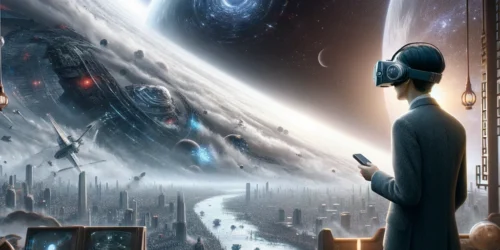Quantum Paranormal

Quantum Paranormal: A 21st Century Analysis of Paranormal Phenomena by Patrick Jackson offers a detailed exploration of how quantum mechanics might provide plausible explanations for various paranormal phenomena, such as UFOs, UAPs, ghosts, and other mysterious occurrences. Jackson’s approach remains firmly grounded in scientific theories, particularly focusing on quantum mechanics, diverging from traditional paranormal explanations rooted in spirituality or pseudoscience. He claims that many paranormal experiences, including ghost sightings and UFO encounters, can be explained through the principles of quantum physics, especially phenomena like quantum entanglement, superposition, and parallel dimensions.
According to Jackson, quantum theory allows multiple realities to coexist, and it is possible that people are witnessing entities or objects from alternate dimensions that occasionally intersect with our own. This concept is central to the book, as Jackson suggests that these fleeting glimpses of otherworldly entities are not hallucinations but are instead part of the fabric of reality, made possible by quantum fluctuations.
One of the central themes in Quantum Paranormal is the relationship between electromagnetic fields (EMFs) and paranormal encounters. Jackson posits that paranormal phenomena are often associated with areas of high electromagnetic activity. He suggests that fluctuating EMF levels in haunted locations may either interfere with human perception or create openings through which interdimensional beings can manifest. Jackson further explains that certain technological tools, such as electromagnetic detection devices, have played a crucial role in capturing paranormal evidence that aligns with his quantum-based theories. These tools have been employed in numerous experiments that have detected unexplained phenomena, including the use of military-grade radar to observe UAPs, strengthening the connection between quantum theory and physical manifestations of these events.
The book also looks into the role of human consciousness within the quantum realm. Jackson asserts that consciousness itself may be a quantum phenomenon, allowing individuals to access different realities or dimensions. Experiences such as telepathy, astral projection, and remote viewing, according to Jackson, might be explained as consciousness interacting with the quantum field. He argues that some people are more sensitive to these quantum interactions and, as a result, are more likely to experience paranormal events. This theory suggests that consciousness, being deeply tied to the quantum world, plays a significant role in shaping how people perceive and interact with unseen dimensions.
In Quantum Paranormal, UAPs are given significant attention, and Jackson provides a scientific framework for understanding them. He argues that these aerial phenomena could be the result of advanced technologies that manipulate space-time by utilizing quantum mechanics. Rather than being physical objects from distant planets, UAPs may represent distortions in the fabric of space-time, caused by beings or technologies operating from higher-dimensional planes. This idea leads Jackson to the conclusion that many entities traditionally categorized as aliens are more likely interdimensional beings with the ability to cross between realities at will. He theorizes that quantum entanglement could explain how these beings or objects appear in one place and disappear just as quickly, without the need for traditional physical travel.
Another key concept in Jackson’s work is the existence of non-human intelligences (NHIs), which he suggests are quantum entities that exist beyond our standard understanding of time and space. These beings, according to Jackson, may have been interacting with humans throughout history, but they are not extraterrestrial in the way they are typically imagined. Instead, these NHIs exist in quantum states and may choose to interact with humans for reasons unknown but possibly related to individuals who are more attuned to the quantum field.
The role of perception is another focal point in Quantum Paranormal. Jackson emphasizes that our brains act as filters for quantum information, and those who have heightened neurological sensitivity may be more likely to witness paranormal phenomena. He speculates that the brain’s interaction with quantum particles could explain common paranormal experiences such as déjà vu, precognition, and other psychic phenomena. The idea is that the brain, through quantum mechanics, allows us to briefly glimpse alternate realities or future events, which accounts for these seemingly inexplicable experiences.
Patrick Jackson does discuss UFO spheres extensively, offering a unique perspective on their nature and purpose. According to Jackson, these spherical objects are not necessarily hostile or alien in the conventional sense. Instead, he suggests that they are here to protect us. He likens the UFO spheres to objects that pilots encountered during World War II, sometimes referred to as “foo fighters.” Jackson categorizes them into different types—Type 1, Type 2, and Type 3—each with its own altitude and function.
He claims that the Type 1 spheres, for example, operate at extremely high altitudes (around 100,000 feet) and serve as guardians of Earth’s airspace, intercepting potentially harmful entities or foreign craft. These spheres, he argues, operate in swarms and are involved in controlling access to Earth’s atmosphere, preventing interference from external groups, including possibly other hostile UFOs.
He claims that Type 2 spheres operate at lower altitudes compared to the Type 1 spheres, which are usually found at 100,000 feet. The Type 2 spheres, according to Jackson, are responsible for monitoring Earth’s atmosphere and intervening in activities involving hostile entities or objects entering our airspace. They serve as part of a global defense network, designed to protect Earth by interacting with other UFOs, preventing potentially dangerous encounters. Jackson suggests that these spheres move in coordinated swarms and have been present for decades, with their appearance dating back to encounters in the 1940s.
Patrick Jackson claims that the Type 3 spheres are particularly interesting due to their unique behavior and interaction with environments like homes and buildings. According to Jackson, these spheres have been known to seek out structures to shield themselves from emitting harmful radiation. This behavior is linked to their purpose as part of a larger defense mechanism, possibly involving some form of data collection or communication process. Jackson theorizes that the presence of poltergeist-like activity in certain haunted houses is a “scarecrow” protocol used by the spheres to deter humans from approaching them when they are engaged in these operations. The theory suggests that footsteps or bangs may lure individuals away to avoid harm during times of data uploads or bursts of energy.
Moreover, Jackson introduces the idea that these Type 3 spheres may function within a broader network, possibly using microwave communications, and this might explain why they appear in clusters or sequences. Their movements and interactions with buildings could be tied to avoiding detection or preventing interference from human activity. This is part of his overarching theory that the spheres operate under some kind of artificial intelligence, and their appearance is not accidental but rather deliberate and purposeful, often as part of a protective or defensive strategy.
He emphasizes that these objects are interdimensional in nature, potentially using advanced quantum mechanics to shift between dimensions, which explains their elusive and transient nature. Jackson argues that these spheres, often mistaken for extraterrestrial crafts, are in fact safeguarding our planet from unknown threats.
Jackson’s interpretation of these spheres fits within his broader quantum theory of paranormal phenomena, where he explores the idea that these objects may be interdimensional rather than extraterrestrial. The idea is that these spheres could be manifestations of quantum phenomena or entities moving through dimensions, with their sudden appearances and disappearances being a result of their interaction with different layers of reality.
Throughout Quantum Paranormal, Jackson references key scientific figures who have contributed to the development of quantum theory. He frequently mentions Albert Einstein’s work on relativity, though he critiques Einstein’s resistance to certain aspects of quantum mechanics. Niels Bohr and Werner Heisenberg are acknowledged for their pioneering work on quantum superposition and uncertainty, which Jackson uses as a basis for understanding how paranormal phenomena could operate in a quantum universe. Additionally, David Bohm’s theory of the implicate order, which suggests that everything is connected at a deeper level of reality, is used to explain the interconnectedness of dimensions and the sporadic nature of paranormal events.
Jackson’s exploration into the quantum realm also includes references to modern theoretical physicists, such as Michio Kaku, who has popularized ideas about the multiverse and string theory. While Kaku is not directly involved in paranormal research, his theories provide a framework for understanding how parallel dimensions could be the source of strange and unexplained occurrences. Furthermore, Jackson mentions figures like John Alexander, a military researcher who has investigated paranormal phenomena and UAPs, highlighting how serious scientific inquiry is beginning to intersect with traditionally fringe topics.
Quantum Paranormal presents a groundbreaking, scientifically-rooted analysis of paranormal phenomena, with a specific focus on quantum mechanics as the explanation for events that have puzzled humanity for centuries. Jackson’s exploration offers a fresh perspective, bridging the gap between hard science and the mysterious realm of the supernatural. His book opens the door to new possibilities, suggesting that what we perceive as paranormal may, in fact, be the natural result of a universe far more complex and interconnected than we have ever imagined.



